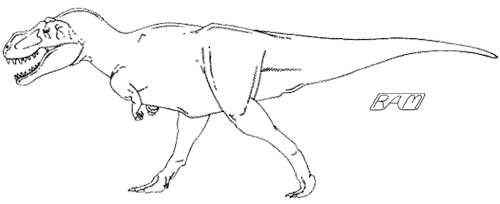Giants: Tyrannosaurus rex
Maximum Length = 45 feet (13.7 metres)
Maximum Weight = 6 tons (5.4 tonnes)*

Tyrannosaurus rex, whose name means, "tyrant lizard-king", is just about every dinosaur lover's favorite. Appearing in the late Cretaceous Period, T. rex was — until recently — the largest carnivorous dinosaur and the largest known terrestrial carnivore (that distinction is now held by Gigantosaurus carolinii). T. rex's head alone was 4 feet (1.2 metres) long and armed with numerous serrated teeth, each measuring some 6 inches (15 centimetres) in length. T. rex seems to have fed primarily on hadrosaurs (or duck-billed dinosaurs) that browsed the hardwood forests of North America during the late Cretaceous. These animals lived in herds and were always on the alert, so it seems likely that T. rex either ambushed them by hiding among the trees or scavenged their carcasses after they had died from some other cause. Traditionally, T. rex has been portrayed as a slow-moving scavenger. This idea was re-examined during the 1960's, paying particular attention to the structure of this animal's hips and legs. In the 1990's, paleontologist Jack Horner re-proposed that T. rex was primarily a scavenger of animals killed by other predators, noting its large olfactory (scent-detecting) bulbs, short and nearly useless forelimbs, and the relative proportion of its upper and lower leg bones — which are not well suited to active pursuit. This view of T. rex as a lowly scavenger has not been popular with those dinosaur fans who very much want to believe it was "the most terrifying predator ever to walk the earth". Only about 15 relatively complete T. rex skeletons have been found to date and one of them, nicknamed "Sue", recently sold to the Field Museum of Natural History in Chicago for US$8.36 Million and sparked a heated controversy about the ethics of selling-off valuable paleontological specimens to the highest bidder.
* 1 ton = 2,000 pounds: 1 tonne = 1,000 kilograms
